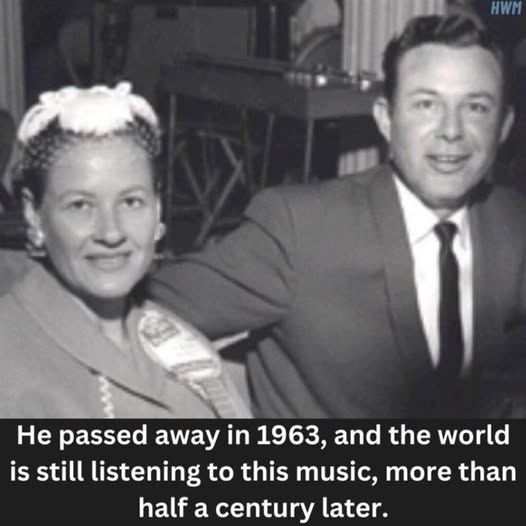In 1960, Jim Reeves released a song that didn’t just climb the charts—it reshaped country music. “He’ll Have to Go” wasn’t loud, flashy, or complicated. It was simple, intimate, and delivered with a quiet, confident charm only Reeves possessed. More than six decades later, people still point to this single track as one of the finest recordings in American music history.
Reeves wasn’t just another guy with a guitar. By the time this song came out, he had already carved his own path in country music: smooth, polished, and far more refined than the honky-tonk sound that dominated the era. Fans called him “Gentleman Jim,” and the nickname suited him perfectly. When he sang, it didn’t feel like a performance—it felt as if he were speaking directly to you in a dimly lit room, intimate and sincere.
“He’ll Have to Go” was inspired by a very real, almost everyday moment. The songwriters, Joe and Audrey Allison, based it on a scene Joe witnessed in a bar: a man pleading into a pay phone, trying to salvage a relationship slipping away. That raw, understated desperation became the heart of the song. Reeves took that emotion, wrapped it in silk, and delivered what is now considered the definitive version.
From the very first line—“Put your sweet lips a little closer to the phone”—Reeves commanded attention. His tone wasn’t frantic or loud. It was calm, almost resigned, yet powerful in its restraint. This subtle approach set him apart. While other artists pushed harder and sang louder, Reeves pulled back. He created tension by staying still, letting every note carry weight. The country music world had never heard anything quite like it.
Chet Atkins, one of Nashville’s greatest creative forces at the time, produced the track. Instead of layering heavy instrumentation, he stripped everything down. The arrangement was minimal: soft background rhythm, faint harmonies, and Reeves’ voice front and center. That restraint made the song shine. The space around his voice allowed the story to breathe, creating an intimacy rarely heard in country music before.
The public responded immediately. “He’ll Have to Go” shot to No. 1 on the Billboard Country Chart and stayed there for weeks. Even more remarkable, it crossed over to the Pop Chart, reaching No. 2—a rare feat for a country record at the time. Its success signaled a major shift in the industry: the Nashville Sound had arrived. Smooth, orchestrated, radio-friendly country wasn’t just accepted—it sold.
But chart success alone doesn’t explain why the song endured. It became a cultural touchstone: the kind of track played in diners late at night, the kind couples danced to in dimly lit kitchens, the kind lonely travelers hummed on long drives. It captured something universal: longing mixed with quiet resignation. Reeves didn’t simply sing heartbreak—he dissected it, exposing the tender, human emotion underneath.
The song’s influence reached far beyond America. Reeves became a global phenomenon, one of the first true international ambassadors of country music. He toured in Africa, Europe, and Asia, winning over audiences who barely spoke English but could feel the emotion in his voice. This international exposure laid the groundwork for future crossover artists.
Covers of the song followed quickly. Elvis Presley tried it, as did Ry Cooder, Conway Twitty, and many others. Yet no version has matched the warmth, precision, and authority Reeves brought to his three-and-a-half-minute masterpiece.
Tragically, Jim Reeves’ career was cut short. In 1964, just four years after “He’ll Have to Go” was released, he died in a plane crash at age 40. His death shook the music world. Fans lost not just a star, but a man who had fundamentally reshaped a genre. Nashville felt the loss deeply—and in many ways, it never fully recovered.
Yet Reeves’ music didn’t fade. If anything, his early death cemented his legacy. Country stations kept his songs in rotation. Jukeboxes never retired “He’ll Have to Go.” New generations discovered him through parents or grandparents who treated his voice like a cherished family heirloom. Eventually, Reeves was inducted into the Country Music Hall of Fame—a formality more than an honor, as he had already earned his place long before the ceremony.
What makes “He’ll Have to Go” timeless is its simplicity. No complicated metaphors, no overproduced flash—just a voice, a story, and a melody crafted for anyone who has ever wanted someone they couldn’t quite have. It feels real because it is real: human longing distilled into sound.
Jim Reeves’ influence is still felt in modern music. The concept of a country-pop crossover—something artists like Taylor Swift, Shania Twain, and Keith Urban rely on—traces directly back to Reeves and the Nashville Sound he helped define. Without him, the evolution of country music would look very different.
He proved that country didn’t have to be rough to be authentic. It didn’t need twang to be powerful. Emotion, delivered with restraint, could hit even harder. “He’ll Have to Go” remains the clearest example of that brilliance—a masterclass in storytelling and vocal control that holds you still the moment it begins.
More than 60 years later, it stands as one of the greatest recordings ever made—a piece of music history that refuses to age.
If someone in your life hasn’t heard Jim Reeves yet, share this song with them. Let them hear what true craftsmanship sounds like. Some voices fade away, but Jim Reeves’ velvet baritone—the one that changed country forever—remains timeless.
